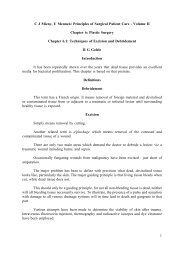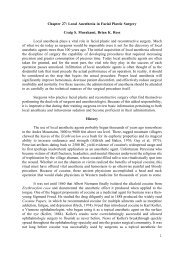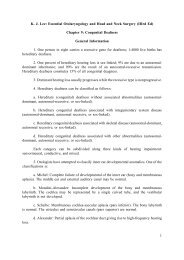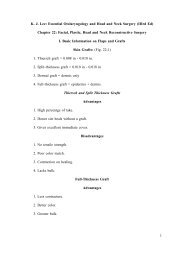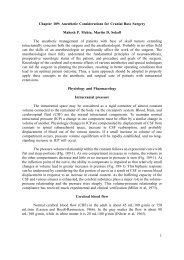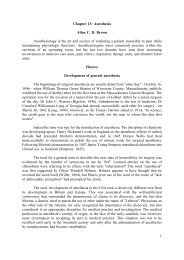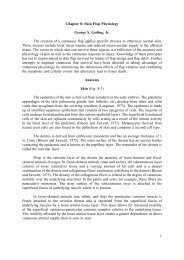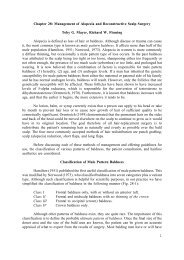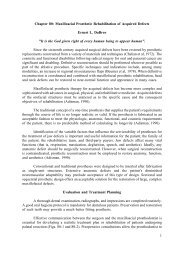1 Chapter 99: Congenital Disorders of the Larynx ... - Famona Site
1 Chapter 99: Congenital Disorders of the Larynx ... - Famona Site
1 Chapter 99: Congenital Disorders of the Larynx ... - Famona Site
You also want an ePaper? Increase the reach of your titles
YUMPU automatically turns print PDFs into web optimized ePapers that Google loves.
History <strong>of</strong> Clinical Features<br />
Significant facts relating to <strong>the</strong> congenital abnormality are obtained from <strong>the</strong> parents,<br />
<strong>the</strong> medical attendants (including <strong>the</strong> obstetrician, pediatrician, or neonatologist), and <strong>the</strong><br />
nursing staff.<br />
The nature <strong>of</strong> <strong>the</strong> mo<strong>the</strong>r's pregnancy (hydramnios is associated with<br />
tracheoesophageal fistula) and <strong>the</strong> course <strong>of</strong> <strong>the</strong> perinatal period (a traumatic or forceps<br />
delivery may cause nasal trauma) are important. Some clinical conditions, such as severe<br />
micrognathia, are obvious as soon as <strong>the</strong> baby is born. Neonatal respiratory distress caused<br />
by major airway obstruction may be apparent immediately after birth: bilateral choanal atresia,<br />
bilateral vocal cord paralysis, large congenital cyst, or major laryngeal web. Periods <strong>of</strong><br />
cyanosis can accompany <strong>the</strong> stridor associated with total nasal obstruction, but if <strong>the</strong> infant<br />
cries and takes a breath through <strong>the</strong> mouth, <strong>the</strong> airway obstruction is momentarily relieved.<br />
If both vocal cords are paralyzed, stridor is always present, <strong>the</strong> cry may be weak, and<br />
mucus may be aspirated. A muffled or absent cry suggests supraglottic pharyngeal obstruction<br />
caused by a cyst or a mass. A harsh barking cough or biphasic inspiratory and expiratory<br />
stridor, especially with retraction <strong>of</strong> <strong>the</strong> head and neck, suggests tracheal obstruction caused<br />
by stenosis, compression, or collapse.<br />
A history <strong>of</strong> respiratory distress and aspiration with feeding in <strong>the</strong> neonatal period<br />
signals <strong>the</strong> possibility <strong>of</strong> a communication between <strong>the</strong> respiratory and digestive tracts, such<br />
as a tracheoesophageal fistula or a posterior laryngeal cleft.<br />
Some congenital lesions do not present <strong>the</strong>ir features at birth, and <strong>the</strong> features are<br />
delayed for some days or weeks. Examples include laryngomalacia, in which <strong>the</strong> stridor may<br />
not appear for several days or even a week or more after birth; vascular compression <strong>of</strong> <strong>the</strong><br />
trachea, which may appear weeks or months after birth; and subglottic hemangioma, <strong>the</strong><br />
symptoms <strong>of</strong> which may not appear for several months.<br />
Physical Examination<br />
General examination<br />
An estimated 10% <strong>of</strong> all newborn babies, especially those who are premature, have<br />
some form <strong>of</strong> respiratory difficulty in <strong>the</strong> first few hours <strong>of</strong> life, but most recover quickly.<br />
Most cases <strong>of</strong> respiratory distress are caused by hyaline membrane disease; some are caused<br />
by respiratory depression from drugs. Probably less than 5% <strong>of</strong> persistent neonatal respiratory<br />
distress is caused by congenital anomalies <strong>of</strong> <strong>the</strong> upper respiratory tract, but <strong>the</strong>y are <strong>of</strong> great<br />
significance. When one anomaly exists, one must remember that o<strong>the</strong>r anomalies may also<br />
exist, ei<strong>the</strong>r in <strong>the</strong> respiratory tract or in o<strong>the</strong>r organ systems.<br />
Examination may show respiratory distress, a rapid or even slow respiratory rate, and<br />
signs <strong>of</strong> hypoxia or cyanosis. The normal respiratory rate is rapid in a newborn baby and<br />
slower in older children. Physical signs found in a general examination <strong>of</strong> <strong>the</strong> baby may lead<br />
to suspicion <strong>of</strong> a specific condition.<br />
3




